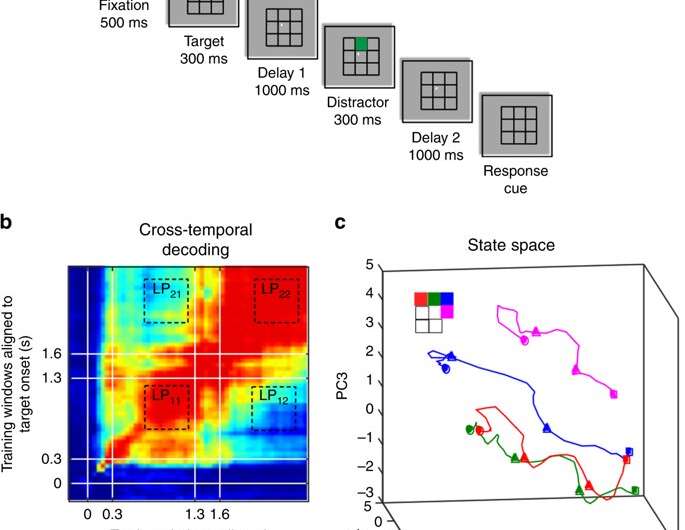Experimental design and code-morphing. a Behavioral task: each trial began when the animal fixated on a fixation spot in the center of the screen. The animal was required to maintain fixation throughout the trial until the fixation spot disappeared. A target (red square) was presented for 300 ms followed by a 1000-ms delay period (Delay 1). A distractor (green square) was then presented for 300 ms in a random location that was different from the target location, and was followed by a second delay of 1000 ms (Delay 2). After Delay 2, the fixation spot disappeared, which was the Go cue for the animal to report, using an eye movement, the location of the target. b Heat map showing the cross-temporal population-decoding performance in the LPFC. White lines indicate target presentation (0–0.3 s) and distractor presentation (1.3–1.6 s). c Responses of the LPFC population when projected onto the first three principal components (PC) of the combined Delay 1 and Delay 2 response space. The responses for different target locations are color-coded using the color scheme shown in the top left. The trajectories illustrate the evolution of the responses from 500 ms before the end of Delay 1 (square), distractor onset (first triangle), distractor offset (second triangle), and the end of Delay 2 (circle). The trajectories of only four of the seven target locations are shown here for clarity
Researchers working in The N.1 Institute for Health at NUS, led by Assistant Professor Camilo Libedinsky from NUS Psychology, and Senior Lecturer Shih-Cheng Yen from the Innovation and Design Programme at NUS Engineering, have discovered that a population of neurons in the brain's frontal lobe contain stable short-term memory information within dynamically-changing neural activity.
This discovery may have far-reaching consequences in understanding how organisms have the ability to perform multiple mental operations simultaneously, such as remembering, paying attention and making a decision, using a brain of limited size.
The results of this study were published in the journal Nature Communications on 1 November 2019.
Mapping short-term memory in the frontal lobe
In the human brain, the frontal lobe plays an important role in processing short-term memories. Short-term memory has a low capacity to retain information. "It can usually only hold six to eight items. Think for example about our ability to remember a phone number for a few seconds—that uses short-term memory," Asst Prof Libendisky explained.
Here, the NUS researchers studied how the frontal lobe represents short-term memory information by measuring the activity of many neurons. Previous results from the researchers had shown that if a distraction was presented during the memory maintenance period, it changed the code used by frontal lobe neurons that encode the memory.
"This was counterintuitive since the memory was stable but the code changed. In this study, we solved this riddle," Asst Prof Libedinsky said. Employing tools derived from machine learning, the researchers showed that stable information can be found within the changing neural population code.
This means that the NUS team demonstrated that memory information can be read out from a population of neurons that morphs their code after a distractor is presented.
Next steps
This simple finding has broader implications, suggesting that a single neural population may contain multiple independent types of information that do not interfere with each other. "This may be an important property of organisms that display cognitive flexibility," Asst Prof Libedinsky explained.
The researchers are currently extending these studies to explore of how multiple brain regions interact with each other with the objective of transferring and processing different types of information. This can be achieved by an interplay between making measurements in biological networks and simulating artificial neural networks that emulate their function. The researchers are also exploring these processes in unhealthy brains, such as those with dementia.
More information: Aishwarya Parthasarathy et al. Time-invariant working memory representations in the presence of code-morphing in the lateral prefrontal cortex, Nature Communications (2019). DOI: 10.1038/s41467-019-12841-y
Journal information: Nature Communications
Provided by National University of Singapore























